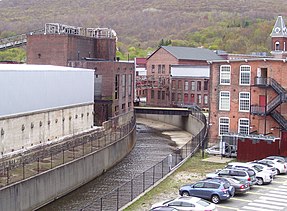MASS MoCA
 |
|
| Established | 1999 |
|---|---|
| Location | North Adams, Massachusetts |
| Director | Joseph C. Thompson |
| Website | www.massmoca.org |
|
Arnold Print Works
|
|

Buildings of the Arnold Print Works, now MASS MoCA, along a tributary of the Hoosic River (2012)
|
|
| Location | 87 Marshall St., North Adams, Massachusetts |
|---|---|
| Coordinates | 42°42′5″N 73°6′59″W / 42.70139°N 73.11639°WCoordinates: 42°42′5″N 73°6′59″W / 42.70139°N 73.11639°W |
| Area | 24 acres (9.7 ha) |
| Built | 1872 |
| Architectural style | Italianate Industrial |
| MPS | North Adams MRA |
| NRHP Reference # | |
| Added to NRHP | October 25, 1985 |
The Massachusetts Museum of Contemporary Art (MASS MoCA) is a museum in a converted factory building complex located in North Adams, Massachusetts. It is one of the largest centers for contemporary visual art and performing arts in the United States. The complex was built by the Arnold Print Works, a business which operated on the site from 1860 to 1942, and was used by the Sprague Electric Company before its conversion.
MASS MoCA opened with 19 galleries and 100,000 sq ft (9,300 m2) of exhibition space in 1999. In addition to housing galleries and performing arts spaces, it also rents space to commercial tenants. It is the home of the Bang on a Can Summer Institute, where composers and performers from around the world come to create and perform new music. The festival, started in 2001, includes concerts in galleries for three weeks during the summer. Starting in 2010, MASS MoCA has become the home for the Solid Sound Music Festival, curated by Wilco. The three-day-long festival takes place all over MASS MoCA's campus.
The buildings that MASS MoCA now occupies were originally built between 1870 and 1900 by the company Arnold Print Works. These buildings, however, were not the first to occupy this site. Since colonial times small-scale industries had been located on this strategic peninsular location between the north and south branches of the Hoosic River. In 1860 the Arnold brothers arrived at this site and set up their company with the latest equipment for printing cloth. They began operating in 1862 and quickly took off. Aiding their success were large government contracts during the Civil War to supply cloth for the Union Army.
In December 1871, a fire swept through the Arnold Print Works factory and destroyed eight of its buildings. Rebuilding started almost immediately and an expanded complex was finished in 1874. Despite a nationwide depression during the 1870s Arnold Print Works purchased additional land along the Hoosic River and constructed new buildings. By 1900, every building but one in today's Marshall Street complex was constructed.
...
Wikipedia


